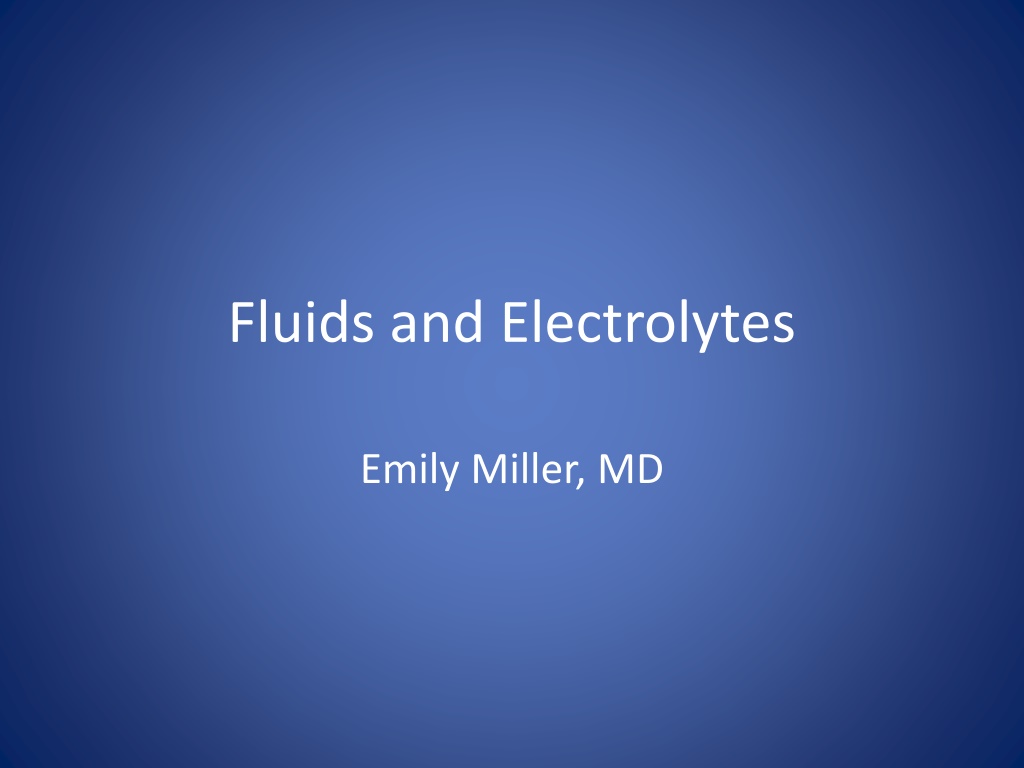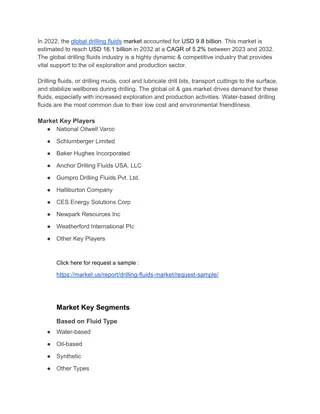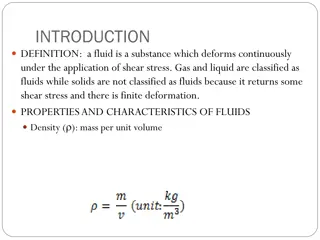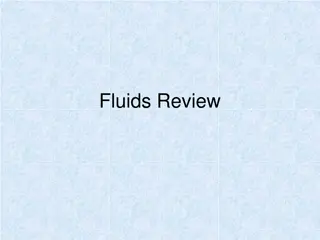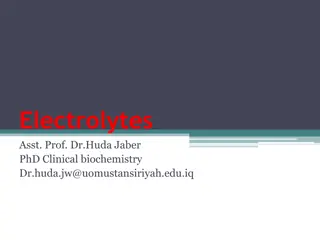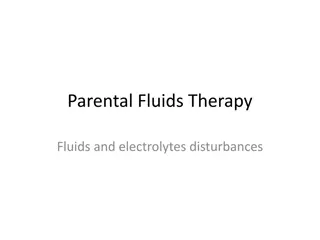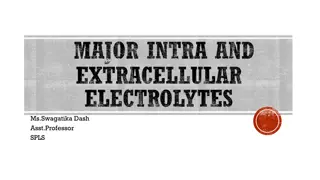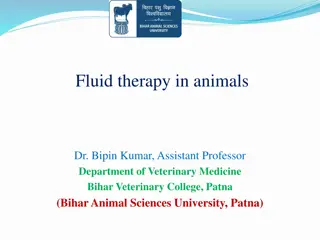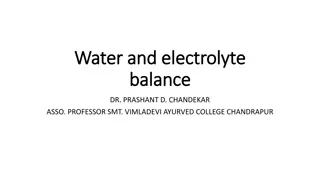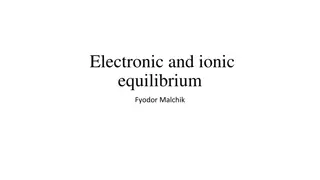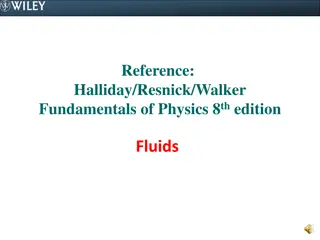Understanding Fluids and Electrolytes in Clinical Practice
This educational material by Dr. Emily Miller provides a comprehensive overview of major electrolytes, common fluid and electrolyte issues in the PICU, including causes and treatment of hyponatremia and hypernatremia. It also includes multiple-choice questions to test knowledge on the topic. The content covers essential information for healthcare professionals managing patients with fluid and electrolyte imbalances.
Download Presentation

Please find below an Image/Link to download the presentation.
The content on the website is provided AS IS for your information and personal use only. It may not be sold, licensed, or shared on other websites without obtaining consent from the author. Download presentation by click this link. If you encounter any issues during the download, it is possible that the publisher has removed the file from their server.
E N D
Presentation Transcript
Fluids and Electrolytes Emily Miller, MD
What We Will Discuss Major electrolytes, too low, too high and what to do Common fluid and electrolyte issues that we see everyday in the PICU And of course lots multiple choice questions
What We Will Not Discuss TPN Any tubules, glomeruli, or arterioles Ca binding proteins Na-K transporters Dialysis, apart from specific indications
First - Na 90% extracellular Major determinant of extracellular osmolality Very important for CNS Large rapid changes can be life threatening Small changes are harmless but warn of other processes Check electrolytes!
Hyponatremia - causes Decreased Na increased loses, AI, CSW, diuretics, osmotic loses (DKA) Increased Na free water retention exceeds Na retention, CHF, cirrhosis, nephrotic syndrome, renal failure Normal Na - SIADH
Which of the following drugs is NOT associated with SIADH A. Vincristine B. Haldol C. Azithromycin D. Ecstasy E. SSRI C. Azithromycin
Hyponatremia: Symptoms & Treatment Cellular swelling and cerebral edema Lethargy, N/V, cramps, confusions Seizures and coma <120 (acute) Chronically CNS cells compensate rapid correction - osmotic demyelination Treatment 1st stop herniation/seizures 5-6 ml/kg 3% will raise Na 5mEq/L Chronic or acute with CNS sx 0.5mEq/L/h Acute with no CNS sx 0.7-1mEq/L/h MUST follow levels!
How many mEq of Na are in a L of 3% Saline A. 513 B. 462 C. 300 D. A lot E. Too much math Answer A. Normal saline is 0.9% 154mEq/L. Divide by 9. Add to 154 to get 1% saline . Multiple by 3. Other options include google. Note normal saline is actually not.
Hypernatremia: Causes Decreased Na free water loses > Na loses, diarrhea, iatrogenic from insufficient free water, diuresis Normal Na DI Increased Na usually iatrogenic 3% in TBI, NaHCO3during resuscitation, improperly prepared infant formula
Hypernatremia: Symptoms & Treatment Increased osmolality, most issues in CNS Irritability, spasticity, N/V, seizures, coma and of course death Decreased brain cell volume tearing of vessels, subcortical or subdural bleeds, vascular congestion, CVT, demyelination Accumulation of idiogenic osm in CNS cells occurs with time Rapid correction brain edema Correct over 48 h no faster than 1 mEq/L/H
Your otherwise stable TBI patient is on 3% saline gtt. Na is 156. Labs show non-gap metabolic acidosis. WTF? A. Shock B. Hyperchloremia C. Hyperphosphatemia D. New onset DKA E. Salicylate abuse Answer: B in setting of hyperchloremia, kidneys waste bicarb to maintain electro-neutrality.
Now, K+ Mostly intracellular Hypokalemia is common, rarely fatal Hyperkalemia is uncommon and very bad Mostly K is managed by kidneys and GI tract Also affected by acid-base balance, insulin, catecholamines, Mg and aldosterone Kidneys secrete K during alkalosis and resorb it during acidosis Cells exchange K+for H+when acidosis is caused by excess H+therefore .
Hyperkalemia seen with DKA is due to: A. Inappropriate fluids in the peds ED and PICU B. Insulin deficiency C. Excess H+ions D. Organic acids E. Everyone knows hyperkalemia with DKA isn t really real, I am SO much smarter than this question Answer: B because the acidosis is caused by organic acids, not H+ions, K+does not leave the cells to maintain electroneutrality, it leaves because of insulin deficiency. Simplified, of course.
Hypokalemia: causes, symptoms & treatment Beta-agonists, hyperaldosteronism, elevated renin, diuretics, osmotic diuresis, GI loses, malnutrition, re- feeding, geophagia, Barium poisoning, Barter syndrome, RTA, drugs Symptoms flattened T-waves, ST depression, U- waves, arrhythmias, weakness, ileus Treat oral 1 mEq/kg or IV 0.5mEq/kg Potential for catastrophic drug error in potassium replacement is real. Ask does this K+really need to be replaced?
Hyperkalemia: Causes, symptoms & Treatment Causes redistribution, administration error, blood products, rhabdo, hemolysis, renal failure, TLS, metabolic acidosis, AI EKG peaked T-waves, decreased P and R wave, widened QRS, bradycardia, classic sine wave blending P and QRS complex EKG can progress over minutes, CPA, V-fib/tach can happen at any point in this progress < 6.5 remove K++/- kayexalate and monitor >6.5 or EKG changes, Ca+2, insulin/glucose, sodium bicarb, albuterol, dialysis, loop/thiazides diuretics
You are NF senior. A pt has a K+of 7.5 with EKG changes. What is the 1st thing you should do? A. Order calcium B. Order insulin/glucose C. Order sodium bicarb D. Call rapid response E. Call code blue F. Call PICU attending Answer: Discuss. Real life is not multiple choice .
Same patient has pulseless v-tach, the first thing you should do? A. CPR B. Defibrillate C. Calcium D. Sodium bicarb E. Insulin F. Call a code blue Answer: start (or make sure someone else starts) CPR. Everything else should happen simultaneously, again really life not multiple choice.
Hypomagnesemia Mostly intracellular, muscle and bone Dietary deficiencies, malabsorption, renal dz Drugs tacrolimus, cyclosporin, amphotercin, cisplatin and diuretics Seizures, hypertension, ventricular arrhythmias, coronary spasm and NM stuff Treat with Mg 25-50 mg/kg watch for respiratory depression and hypotension
Hypermagnesemia Causes- iatrogenic and renal failure Symptoms pseudocoma, hypotension and respiratory depression, arrhythmias (theme), decreased DTRs, eventually flaccid quadriplegia Treatment calcium (direct antagonist), lasix, dialysis
You are the PICU fellow called to RRT for a 15 y/o seizing, unresponsive, hypertensive small bowel transplant patient. You treat the seizure, secure the airway, transfer the patient and order labs. You expect A. High Mg, low tacrolimus B. Low Mg, high tacrolimus C. High Mg, high tacrolimus D. Low Mg, low tacrolimus. Answer: B. Both low Mg and high Tac will lower seizure threshold and will also do so synergistically.
Hypophospatemia Mostly in bones, normal levels vary with age, less is normal with age Symptoms only when < 1.5 no ATP, 2,3-DPG Refeeding syndrome, burns, DKA, respiratory alkolosis, and deficient TPN Symptoms weakness, respiratory depression, decreased O2 delievery Treat .with phos!
Hyperphosphatemia Causes TLS, renal failure, iatrogenic Symptoms hypocalcemia, seizures, cardiac arrest Treat fluids, calcium, mannitol, dialysis
Anorexia, DKA, renal failure and new ALL can all disturb phos, in which directions? A. Re-feeding low phos, DKA high phos, renal failure low phos, TLS high phos B. Re-feeding high phos, DKA low phos, renal failure high phos and TLS low phos C. Re-feeding high phos, DKA high phos, renal failure low phos and TLS high phos D. Re-feeding low phos, DKA low phos, renal failure high phos and TLS high phos Answer: D. Note re-feeding syndrome and TLS are opposite (K+too). DKA pee out too much, renal failure pee out not enough.
Hypocalcemia Causes reduced PTH, vitamin D, alkolosis, hyperphos, drugs/toxins, TLS, blood products (why?), the vague but common critical illness Symptoms decreased muscle contractions, stridor, apnea, tetany, seizures, muscle spasms, hypotension, CHF, arrythmias, prolonged QT Treat calcium. CaCl2only via CVL, calcium gluconate can go in PIV.
Hypercalcemia Causes hyper-PTH, vitamin D toxicity, malignancy, immobility, thiazides Symptoms hypertension, constipation, abdominal pain, polyuria, dehydration, stones, hypotonia, shortened QT, arrhythmias Remember stones, groans, bones and psychiatric moans from Step 1? Treat hydration, lasix, calcitonin ( tones down calcium), bisphosphonates Note with calcium lasix and thiazides have opposite effects.
ICU FEN Issues: How Much? 4:2:1 rule generally applied Vented patients need less, don t lose H2O from respiratory tract 2/3 to 3/4 MIVF Rhabdomyolysis, DKA need more 1.5MIVF Shock, on-going loses replace with boluses as needed or else fluid overload can easily occur Septic shock should not be treated with 1.5 MIVF instead of or even in addition to boluses, you risk fluid overload, high Na, Cl and glucose and you won t find this in ANY septic shock algorithms, go ahead check your PALS card.
ICU FEN issues: what? D5NS +/- KCl is safe go-to fluid Post-operative patients are at risk for hyponatremia should get NS Any neuro pt should absolutely get NS 1/2NS small infants, DKA, borderline high Na 1/4NS only with hypernatremia
PICU FEN Issues when to replace electrolytes? Probably let it be if some or all of below is true Stable patient Moderate deficiency (K or phos of 3.3) Eating patient No expectation of on-going loses Deficit not consistent with clinical picture - suggesting transient or spurious value Probably need to replace if ANY of below is true Symptomatic or critical Severely low levels (Mg is 1) NPO on IVF Expectation of on-going loses (giving more lasix) Deficit is consistent with clinical situation Special cases low Mg in transplants, low Na in TBI
ICU fluid issues: what? TBI no glucose for 72 h Everyone else D5 Small infants or anyone at risk for hypoglycemia, D10
ICU FEN issues: checking labs Most ICU patients need lytes checked at or near admission, especially critical patients, asthmatics, DKA Who needs daily lytes? General guidelines Anyone NPO/IVF Anyone on TPN that is being actively titrated Anyone on diuretics being actively titrated Anyone severely critical
PICU FEN Issues: My patient is not peeing fluids or lasix Lasix No evidence of shock Good perfusion Not tachycardic Normo/hypertensive CVP > 6-8 BUN and Cr normal Suspicion of fluid overload (wet CXR, edema) Clinical explanation for urinary retention (PCA) Fluid Evidence of shock Tachycardia Hypotension Dry mucus membranes, sunken fontanelle Low CVP Elevated BUN Clinical explanation for fluid deficit (GI loses, OR) I am still not sure insert foley
